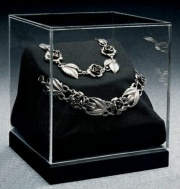Difference between revisions of "Activated carbon"
| Line 31: | Line 31: | ||
==Resources and Citations== | ==Resources and Citations== | ||
| − | + | * Wikipedia: [https://en.wikipedia.org/wiki/Activated_carbon Activated carbon] Accessed July 2023 | |
* G.S.Brady, ''Materials Handbook'', McGraw-Hill Book Co., New York, 1971 Comment: p. 13 | * G.S.Brady, ''Materials Handbook'', McGraw-Hill Book Co., New York, 1971 Comment: p. 13 | ||
| − | |||
* Richard S. Lewis, ''Hawley's Condensed Chemical Dictionary'', Van Nostrand Reinhold, New York, 10th ed., 1993 | * Richard S. Lewis, ''Hawley's Condensed Chemical Dictionary'', Van Nostrand Reinhold, New York, 10th ed., 1993 | ||
| − | |||
* Hermann Kuhn, ''Conservation and Restoration of Works of Art and Antiquities'', Butterworths, London, 1986 | * Hermann Kuhn, ''Conservation and Restoration of Works of Art and Antiquities'', Butterworths, London, 1986 | ||
| − | |||
* Hoechst Celanese Corporation, ''Dictionary of Fiber & Textile Technology'' (older version called Man-made Fiber and Textile Dictionary, 1965), Hoechst Celanese Corporation, Charlotte NC, 1990 | * Hoechst Celanese Corporation, ''Dictionary of Fiber & Textile Technology'' (older version called Man-made Fiber and Textile Dictionary, 1965), Hoechst Celanese Corporation, Charlotte NC, 1990 | ||
| − | |||
* ''A Glossary of Paper Conservation Terms'', Margaret Ellis (ed.), Conservation Center of the Institute of Fine Arts, New York City, 1998 | * ''A Glossary of Paper Conservation Terms'', Margaret Ellis (ed.), Conservation Center of the Institute of Fine Arts, New York City, 1998 | ||
Latest revision as of 12:27, 14 July 2023
Description
An inert, amorphous, black powder of Carbon. Activated carbon has tiny particles with very high surface areas due to their fine, honeycomb pore structure. Activated carbon is obtained by the carbonizing of coal, peach pits, hardwood, animal bones, coconuts, and other carbonaceous material. It is activated by heating to a high temperature (800-900 C) with steam or Carbon dioxide to produce its rigid, sponge-like internal structure. The void spaces, which may occupy up to 75% of its volume, provide sites for molecular adsorption. Activated carbon is primarily used as an adsorbent to remove pollutants and other impurities in both gases and liquids. Activated carbon is available in the form of pellets, powder, or fabric. Commercial uses of the sorbent include gas masks, filter systems, decolorizing sugar, solvent recovery, and purification of water and air.
Synonyms and Related Terms
active carbon; decolorizing carbon; activated charcoal; activated carbon cloth; aktivní uhlí (Ces.); Aktivkohle (Deut.); A-Kohle (Deut.); carbón activado (Esp.); actieve kool (Ned.); wêgiel aktywny (Pol.); (ACC); black pearsl, charcoal black, natural graphite
Brand names:Carbomix; Carboraffin; Medicoal; Ultracarbon; Norit; Carbofine
Risks
- Dust may cause irritation with skin contact or inhalation.
- ThermoFisher: SDS
Physical and Chemical Properties
| Composition | C |
|---|---|
| Density | 0.08 - 0.5 g/ml |
| Molecular Weight | mol. wt. = 12.01 |
| Pore size | 10-70 angstroms |
Resources and Citations
- Wikipedia: Activated carbon Accessed July 2023
- G.S.Brady, Materials Handbook, McGraw-Hill Book Co., New York, 1971 Comment: p. 13
- Richard S. Lewis, Hawley's Condensed Chemical Dictionary, Van Nostrand Reinhold, New York, 10th ed., 1993
- Hermann Kuhn, Conservation and Restoration of Works of Art and Antiquities, Butterworths, London, 1986
- Hoechst Celanese Corporation, Dictionary of Fiber & Textile Technology (older version called Man-made Fiber and Textile Dictionary, 1965), Hoechst Celanese Corporation, Charlotte NC, 1990
- A Glossary of Paper Conservation Terms, Margaret Ellis (ed.), Conservation Center of the Institute of Fine Arts, New York City, 1998
